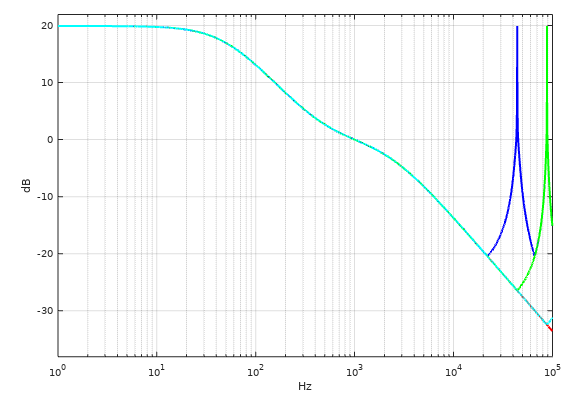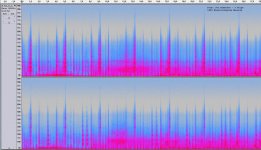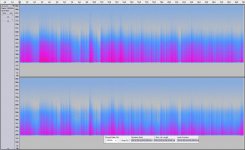For outputting up to 60kHz you'd need use sampling rate of 120kHz (Nyqvist's sampling theorem) --> so, if we follow the common rates, your audio interface should support at least 176.4kHz sampling. Many audio interfaces uses limiter to filter out HF content so ... .
Here are RIAA responses for common, 44100 based sample rates (range 1Hz - 100kHz (blue: 44100, green: x2, cyan: x4 and red: x8)):

Copy of same image attached.
Yes, it is true from the point of view of digital domain, no problem there.
But in the analog domain, bottle neck is the input buffer/preamp.
Moreover, the adc stage is designed to accept data until 20KHz.
Even if he is designed to 'digitalize' data up to 192/384KHz, it doesn't mean it 'read' up to those numbers, but only that it upsample up to 384KHz.
The input stage of an adc is, of course, an analogue one that is designed to compute audio frequency, or up to 20KHz.
It would be a plus if it can accept waveforms up to 60KHz, but it is not at all obvious.
I mean it is possible, but it is not common to have an audio interface capable to acquire, in the analog domain, more than 20KHz.
Edit: if we think about the antialias lpf, it is clear that it would be very strange if the audio band would be more than 20KHz.
Last edited:
Actually, most vinyl pickups don't really reproduce actual music signals much above 20 kHz. What you see is harmonic products (distortion) and noise.
The various 4-channel vinyl formats used ultrasonic frequencies up to 40 kHz for the rear channel information, but that required special pickups and needles, and it was observed that the ultrasonic signal decayed after the record was played several times.
Yes, in a harmful way.
Hi Julf.
Could you post some evidences of your thoughs?
I don't remember where, but some years ago here at diyaudio.com there was a discussion about the 'analog' sound of the vinyls et cetera, and someone did post some (many) frequency spectra that lasted up to 60KHz.
From there and the modulation theory, it seems a good point to imagine that a central role in the 'analog' sound of the treble in a vinyl is due to the extended frequency range.
Anyway, I think a good analog chain is still too much expensive, and a digital chain that will cost the same, will sound the same if not better. (I think better).
Edit: the records up to 60KHz were the ones with trumpets.
Last edited:
Could you post some evidences of your thoughs?
Happy to, but you can look at the specifications or even better actual measurements of popular vinyl pickups.
Here are a couple:
Ortofon MC Anna Diamond - 20-20 kHz -0.4 - +2.1 dB
EMT Jubilee JSD 6 - 20-20 kHz -0.3 - +5.3 dB
As I wrote, yes, frequency spectra can go very high - but it is all harmonics (distortion) and noise. I have to point out that the THD for the pickups above are 0.5-11% and THD 0.3-17% respectively - the higher numbers at higher frequencies, so lots of stuff to fill up a spectrum plot.I don't remember where, but some years ago here at diyaudio.com there was a discussion about the 'analog' sound of the vinyls et cetera, and someone did post some (many) frequency spectra that lasted up to 60KHz.
Unless one takes into account that the extended frequency range is inaudible. I think the noise/rumble (that provides a sense of "space"), harmonic distortion and frequency response coloration accounts for the "vinyl" sound (all sound is analog anyway, so "analog sound" is a bit of a misnomer).From there and the modulation theory, it seems a good point to imagine that a central role in the 'analog' sound of the treble in a vinyl is due to the extended frequency range.
I agree.Anyway, I think a good analog chain is still too much expensive, and a digital chain that will cost the same, will sound the same if not better. (I think better).
Yes, it is true from the point of view of digital domain, no problem there.
But in the analog domain, bottle neck is the input buffer/preamp.
Moreover, the adc stage is designed to accept data until 20KHz.
Even if he is designed to 'digitalize' data up to 192/384KHz, it doesn't mean it 'read' up to those numbers, but only that it upsample up to 384KHz.
The input stage of an adc is, of course, an analogue one that is designed to compute audio frequency, or up to 20KHz.
It would be a plus if it can accept waveforms up to 60KHz, but it is not at all obvious.
I mean it is possible, but it is not common to have an audio interface capable to acquire, in the analog domain, more than 20KHz.
Edit: if we think about the antialias lpf, it is clear that it would be very strange if the audio band would be more than 20KHz.
Attached a spectrum plot from 24-bit/192kHz recording (Technics EPC-205CMK3 - Pro-Ject MM RIAA pre-amp - E-MU 0404 USB (!! 44.1, 48, 88.2, 96, 176.4, 192kHz from internal crystal with no sample rate conversion.))
Attachments
Last edited:
Attached a spectrum plot from 24-bit/192kHz recording (Technics EPC-205CMK3 - Pro-Ject MM RIAA pre-amp - E-MU 0404 USB (!! 44.1, 48, 88.2, 96, 176.4, 192kHz from internal crystal with no sample rate conversion.))
And what part of it is the original signal, and what is distortion/harmonics?
And what part of it is the original signal, and what is distortion/harmonics?
Hmm... who knows, but, that's what I get out from the analog part (TT, RIAA pre-amp) of my vinyl recording setup. If you extract the >20kHz data from linked .flac you still be able to follow the song (structure). Attached the spectrum plot from above 20kHz frequencies.
Attachments
Many audio interfaces uses limiter to filter out HF content so ... .
What is that supposed to mean? Limiting is a time domain concept. I don't know of any ADC that samples at 44.1kHz that has any appreciable content past 22.05kHz unless it is broken or deliberately flawed.
Attached a spectrum plot from 24-bit/192kHz recording (Technics EPC-205CMK3 - Pro-Ject MM RIAA pre-amp - E-MU 0404 USB (!! 44.1, 48, 88.2, 96, 176.4, 192kHz from internal crystal with no sample rate conversion.))
What are you trying to say here? You sampled at 192kHz so there is something possible out to 96kHz (BTW unlikely from the cartridge/LP). Listing the other sample rates has no relevance, besides if you are looking simply at the ADC data sample rate conversion has no meaning.
Last edited:
If you extract the >20kHz data from linked .flac you still be able to follow the song (structure).
That is what you would expect from distortion-caused harmonics.
...
What are you trying to say here? You sampled at 192kHz so there is something possible out to 96kHz (BTW unlikely from the cartridge/LP). ...
205cmk3 outputs up to ~80kHz and when TT is removed from the recording path (RIAA pre-amplifier is still there), left is about flat response after applying inverted RIAA .... 😀
Read also my previous post... 🙄.
That is what you would expect from distortion-caused harmonics.
Hmm... what ever (I can't hear it anyway), but, did you try it (remove all content from below 20kHz, change (not SRC) the sample rate (slow down) so you get the data down to your hearing range ... )?
205cmk3 outputs up to ~80kHz and when TT is removed from the recording path (RIAA pre-amplifier is still there), left is about flat response after applying inverted RIAA .... 😀
Read also my previous post... 🙄.
Most likely power-line/EMI trash incursion.
That is what you would expect from distortion-caused harmonics.
Maybe.
Or maybe not.
I mean, from that data it is not possible to determine what that data are, signal or distorsion.
Why you are so sure that it is distorsion/noise?
I mean, from that data it is not possible to determine what that data are, signal or distorsion.
Indeed. For that you need the original signal.
Because there will definitely be distortion-caused harmonics, and because it is unlikely that there was much original information above 20 kHz.Why you are so sure that it is distorsion/noise?
Hmm... what ever (I can't hear it anyway), but, did you try it (remove all content from below 20kHz, change (not SRC) the sample rate (slow down) so you get the data down to your hearing range ... )?
No, didn't try that, only looked at the spectrum analysis - but if it is caused by harmonic distortion, it is expected to correlate with the original music.
I'm game, will give it a try.
If you do, you might as well then continue, by low-pass filtering the music at 20 kHz, and then adding 5% harmonic distortion, and listen again to hear if there is any real difference.
I can try that. I used to have a software that would add distortion as wanted. Don't remember what is was.
I can try that. I used to have a software that would add distortion as wanted. Don't remember what is was.
Even Audacity can do it.
Most likely power-line/EMI trash incursion.
Nope, that would be seen in spectrum when TT is on-line ... and it isn't there
 .
. Not all recordings give that high frequency content as what my example recording is showing ... I found only handful of cases from my few hundreds LP's collection ... shouldn't "power-line/EMI trash incursion" show up in all cases ... ?
- Home
- Source & Line
- Digital Line Level
- What about digital RIAA?

